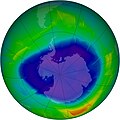ไฟล์:2009 Antarctic Ozone Hole (3927062424).jpg
หน้าตา

ขนาดของตัวอย่างนี้: 600 × 600 พิกเซล ความละเอียดอื่น: 240 × 240 พิกเซล | 480 × 480 พิกเซล | 716 × 716 พิกเซล
ดูภาพที่มีความละเอียดสูงกว่า (716 × 716 พิกเซล, ขนาดไฟล์: 283 กิโลไบต์, ชนิดไมม์: image/jpeg)
ประวัติไฟล์
คลิกวันที่/เวลาเพื่อดูไฟล์ที่ปรากฏในขณะนั้น
| วันที่/เวลา | รูปย่อ | ขนาด | ผู้ใช้ | ความเห็น | |
|---|---|---|---|---|---|
| ปัจจุบัน | 08:28, 12 พฤษภาคม 2561 |  | 716 × 716 (283 กิโลไบต์) | OceanAtoll | Transferred from Flickr via #flickr2commons |
หน้าที่มีภาพนี้
ไม่มีหน้าใดโยงมาที่ภาพนี้
การใช้ไฟล์ข้ามโครงการ
วิกิอื่นต่อไปนี้ใช้ไฟล์นี้:
- การใช้บน de.wikibooks.org
- การใช้บน en.wikibooks.org
